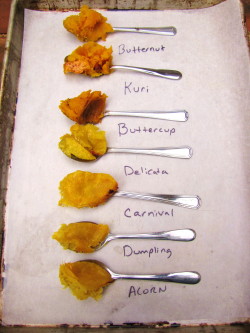
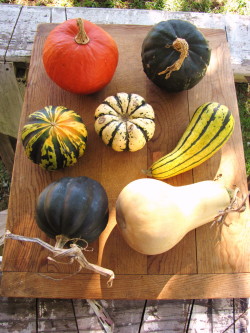 Sometimes, you just don’t know what you’re getting yourself into. Take my boyfriend, Roy, for example. I’m sure when he met me, he had no idea that one day he’d be standing around the kitchen island (which he built for me) with seven spoons and a heap of roasted squash in front of him. Fortunately, what I didn’t know (but suspected) when I met him, is that he’s a really good sport. Last Sunday, he agreed to do the winter squash taste test with me. Lucky him.
Sometimes, you just don’t know what you’re getting yourself into. Take my boyfriend, Roy, for example. I’m sure when he met me, he had no idea that one day he’d be standing around the kitchen island (which he built for me) with seven spoons and a heap of roasted squash in front of him. Fortunately, what I didn’t know (but suspected) when I met him, is that he’s a really good sport. Last Sunday, he agreed to do the winter squash taste test with me. Lucky him.
I dreamed up this little experiment after we found ourselves in possession of several different kinds of winter squash. I’ve loved taste comparisons ever since I was introduced to them at culinary school years ago. We did a lot of them at Fine Cooking, too, in order to recommend brands of chicken stock or canned tomatoes or olive oil to cooks. The worst taste test we ever did was butter. Tasting 8 different brands of butter in one morning will make anyone feel sick. The best? Bittersweet chocolate, of course. In fact, I’ve learned so much about flavor differences in both natural and manmade products over the years from taste tests, that I’m constantly urging other cooks to conduct their own at home. (A great place to start is with something you buy and use a lot, like extra-virgin olive oil. Buy a few different grocery-store brands and taste them side by side to find your favorite—you’ll be amazed at how different they are. Lately I’ve been liking Trader Joe’s Spanish olive oil.)
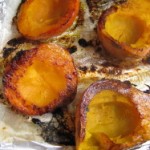
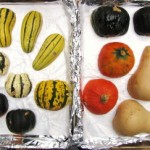 But not to belabor the point, here’s how we conducted the squash test: I cut each of the squash in half, scooped out the seeds, seasoned them ever so lightly with a little salt, and roasted them, cut side-down, on buttered parchment paper, until they were completely tender and lightly caramelized (about 1 hour 20 minutes on average). I turned the squash over, let them cool a bit, and scooped some of the flesh out of each for us to taste side by side. We each had one or two bites of each squash, and I took notes on the taste, texture, and color.
But not to belabor the point, here’s how we conducted the squash test: I cut each of the squash in half, scooped out the seeds, seasoned them ever so lightly with a little salt, and roasted them, cut side-down, on buttered parchment paper, until they were completely tender and lightly caramelized (about 1 hour 20 minutes on average). I turned the squash over, let them cool a bit, and scooped some of the flesh out of each for us to taste side by side. We each had one or two bites of each squash, and I took notes on the taste, texture, and color.
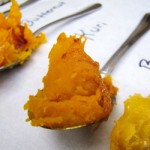
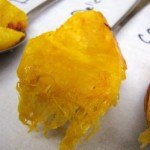 The first thing I noticed of course, before we even tasted, was the big range in color and texture among the squash. (To identify the squash, see the photo at the end of the blog with IDs underneath.)The Red Kuri, Buttercup, and Butternut squash have deep orangey-red flesh and a dense texture. The Delicata, Acorn, Sweet Dumpling, and Carnival all had a more yellowy golden flesh, although within them, the texture varies (Delicata and Dumpling being creamy, Acorn and Carnival more fibrous.) The cool part of the comparison, though, was how different they all tasted. Here’s what we thought.
The first thing I noticed of course, before we even tasted, was the big range in color and texture among the squash. (To identify the squash, see the photo at the end of the blog with IDs underneath.)The Red Kuri, Buttercup, and Butternut squash have deep orangey-red flesh and a dense texture. The Delicata, Acorn, Sweet Dumpling, and Carnival all had a more yellowy golden flesh, although within them, the texture varies (Delicata and Dumpling being creamy, Acorn and Carnival more fibrous.) The cool part of the comparison, though, was how different they all tasted. Here’s what we thought.
Butternut—smooth, rich, dense flesh with a distinctively nutty flavor
Red Kuri—texture like a baked potato, very robust smoky-nutty flavor, intensely “squashy” in a good way; deeply colored (Susie’s favorite)
Buttercup—dense flesh with a very flavorful flesh reminiscent of caramel and peanuts
Delicata—very creamy flesh, light and bright tasting, flavor hints of summer squash
Carnival—moderately fibrous flesh, light sweet-sour flavor, our least favorite (sorry, Carnival)
Sweet Dumpling—flesh is a bit fibrous but creamy too, very sweet with a bit of tang, a light flavor
Acorn—fibrous texture but with a complex nutty-sweet-bright flavor (Roy’s favorite)
So there you have our unofficial and biased results. I’d recommend trying the Red Kuri if you haven’t, and I’d consider using it or Buttercup in place of Butternut in soups for a richer flavor. Though Carnival is a beguiling looking squash, I’d definitely stick with the similar but better tasting Acorn for stuffing, or go with the pleasantly sweet and creamy Delicata or Dumpling.
Squash IDs, clockwise, starting from top left: Butternut, Acorn, Carnival, Red Kuri, Buttercup, Delicata, Sweet Dumpling

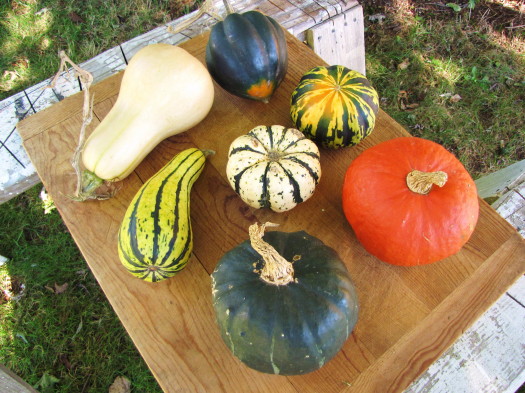
Susie…
I felt like I ran into an old friend this weekend. I was in the Stone Barns Gift Shop (Tarrytown, NY) and when I turned around there were copies of Fast, Fresh and Green! What a nice moment. We would have bought a copy but we both already have one!
Barbara
I’m curious to know what you did with the rest of the roasted squash, or is that for another post? I use the buttercup a lot, it is very common here in Italy and I like to use it together with pumpkin to make soup.
Hey Barbara,
Isn’t Stone Barns the coolest? I love that place, and am so glad they’re carrying my book — yay! I hope you got a chance to eat at the restaurant. And hope all is going well in your new spot. Take care, Susie
Hi Joanne,
I have been using the squash like crazy, both for our meals and for recipe development. I made a roasted squash and roasted apple soup –yum– and put some on pizza with fontina and some in a tart with goat cheese! It’s pretty versatile, and we like it just mashed with a bit of butter and cream, too. The roasting really helps the flavor. (I’m in heavy recipe development mode right now, so fortunately, I do have a friend’s pigs I can feed when we wind up with just too many leftovers…I don’t like to waste food.).
What a fun experiment! I wonder how roasted sweet potato would have tasted alongside the squash? 🙂
It was fun–and actually, there are so many varieties of sweet potato on the market now, too (Jewel, Gem, Garnet and other pretty names!) that you could do a side-by-side just with them!
I also found purple and white sweet potatoes at my local farmer’s market, so I might have to do a taste test of my own.
Hi
I LOVE the squash tasting article!! I just returned from a hayride and pumpkin/squash picking afternoon and cannot wait to have our own tasting. Have you any hubbards on the Vineyard?
A Fan- Kathy Ross (friend of Eliza’s in York)
Hi Kathy,
Yes, we have a Hubbard on our front step!! I didn’t cook it with the others because it is so huge (I’ve heard the best way to open them is to drop them on the floor!), but if you had pieces of it, you could roast it just like the others and then make tasty soup out of it. I hope to cook mine at some point (if the critters don’t get it!). Glad all is well in York — sounds like a wonderful afternoon! Thanks, Susie
Hey Susie,
Loved this post. Reminds me of the kind of testing I used to do…. and haven’t done in awhile! There’s so much to learn in one of these kinds of experiments. So I just want to clarify, the Red Kuri–your favorite–is the one that looks sort of like pumpkin? I’m definitely picking up one next time.
Hey, you best selling author, you — I am getting such a thrill out of watching your new book do so well. You are so great! Enjoyed David’s post the other day too — hope you’re on-the-road gigs are going well! Yes, the red kuri looks like a small pumpkin–skin is deep orange color, almost reddish — a clue to the flesh beneath, which is fabulous! I wish I had time to do more with it. Take care and hope to catch up soon. Susie
Hi Susie, great post! I love doing taste tests as well. It’s so funny, because I just did a winter squash taste test in October for a cooking class I taught. I’ve done it for a couple of years now – it really helps people to decide which squash is worth the effort, so to speak. (I blogged about it too, if you are interested to see how our results compare.)
I love the blog! Cheers, Heidi
Hey Heidi — This is so funny — I just checked out your test and it is extremely thorough! I learned a lot from it (Turban squashes–cool). Great job and nice blog and thanks for getting in touch! Susie
Dear Sue,
I just discovered and enjoyed reading about your taste test. One of the challenges of my 64 years of life and my mother and grandmother before me has been the search for the predictably “dry” squash – the one with texture like an Idaho baked potato. We always use buttercup or hubbard and the results are not consistent. Does anybody know what determines whether the same variety of squash can sometimes come out dry and mealy and anotehr time wet and stringy? I have experiemented with different cooking methods, picking squash with darker, harder skin, or lighter skin, heavier squash for its size or lighter (thinking less water content), all to no avail. The last two driest squash I have found were buttercups with a lighter and shinier skin. In fact, I cooked one today that is so dry that even for me it is nearly inedible. It would have to be beaten with cream and butter to make a side dish from it. Does anybody else have any theories about this?